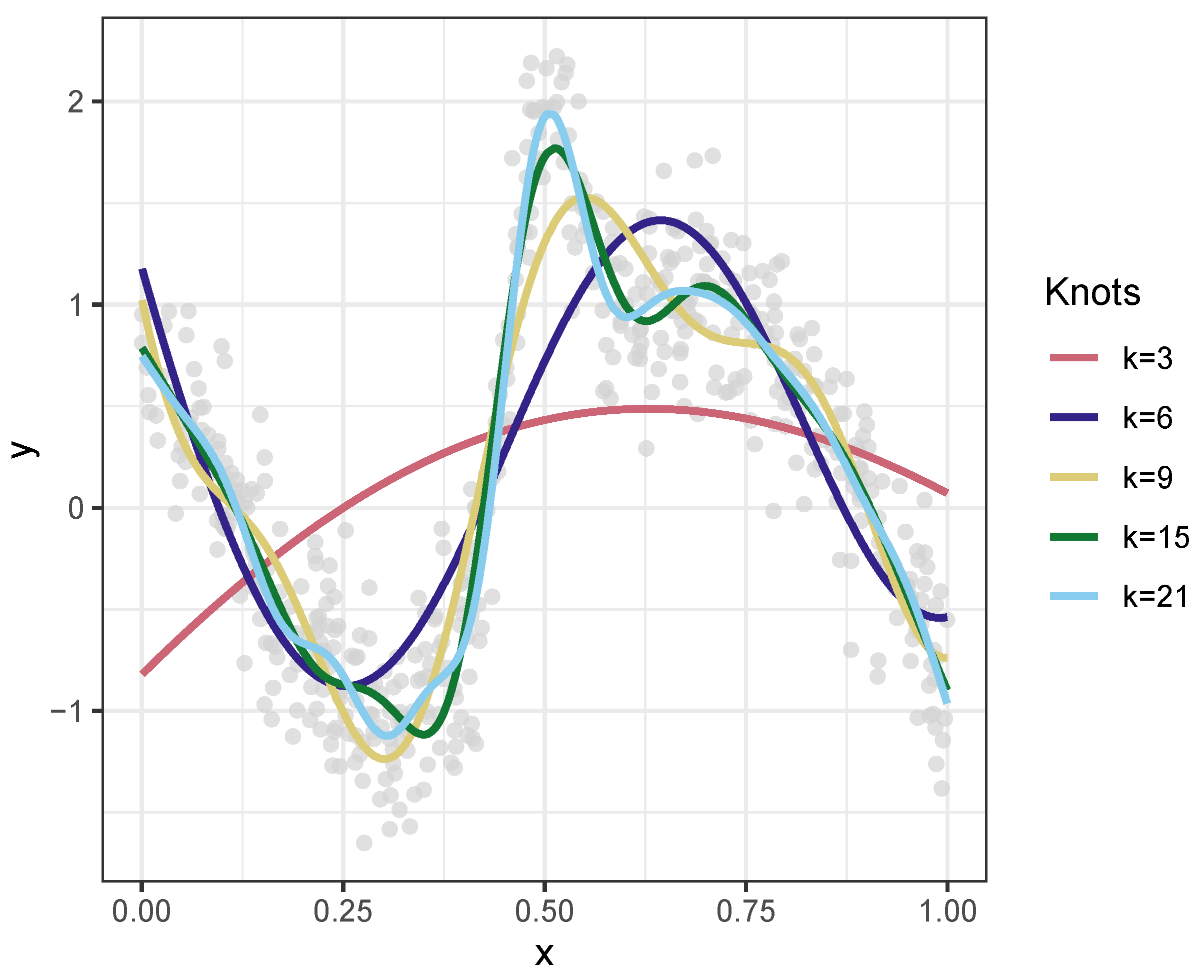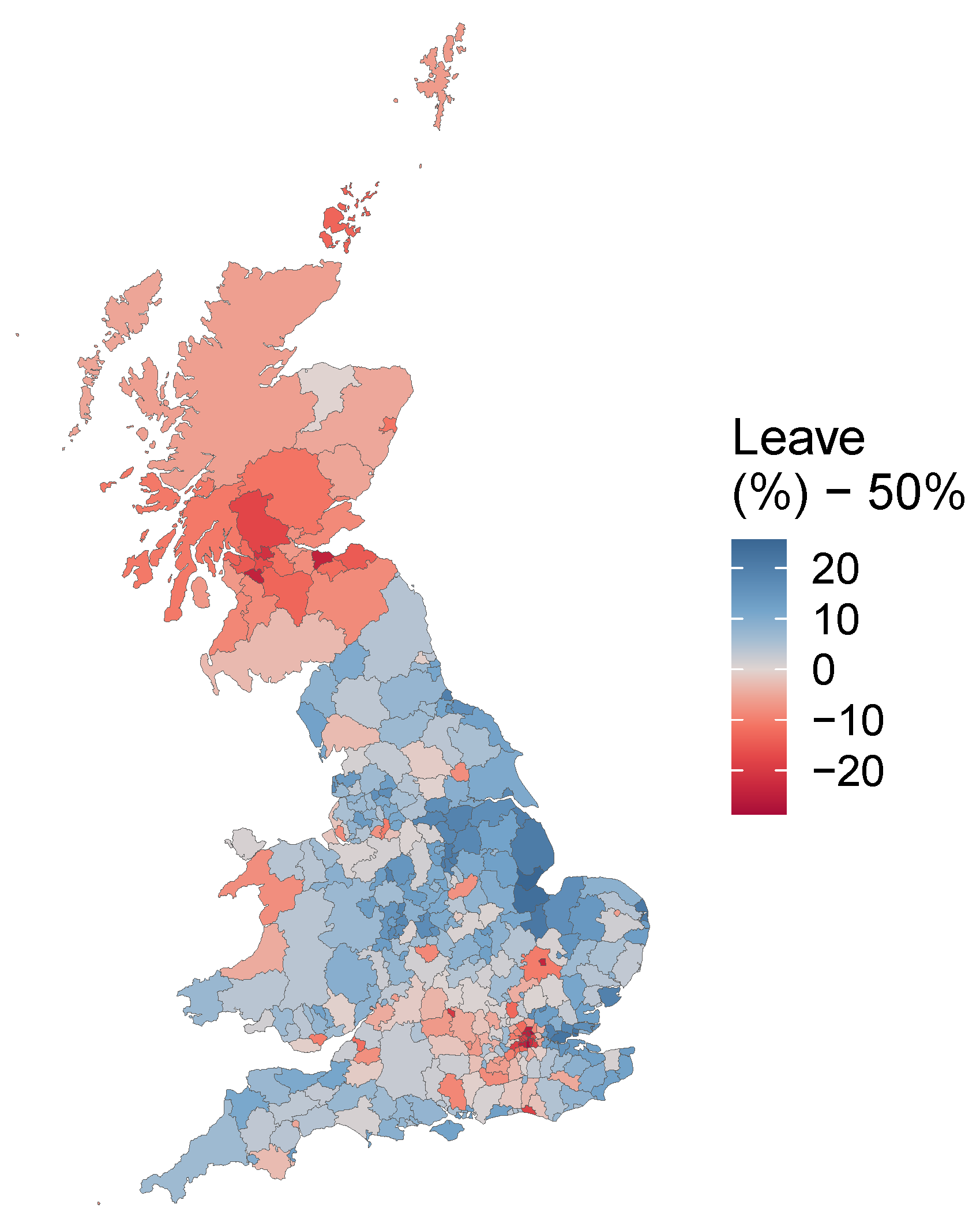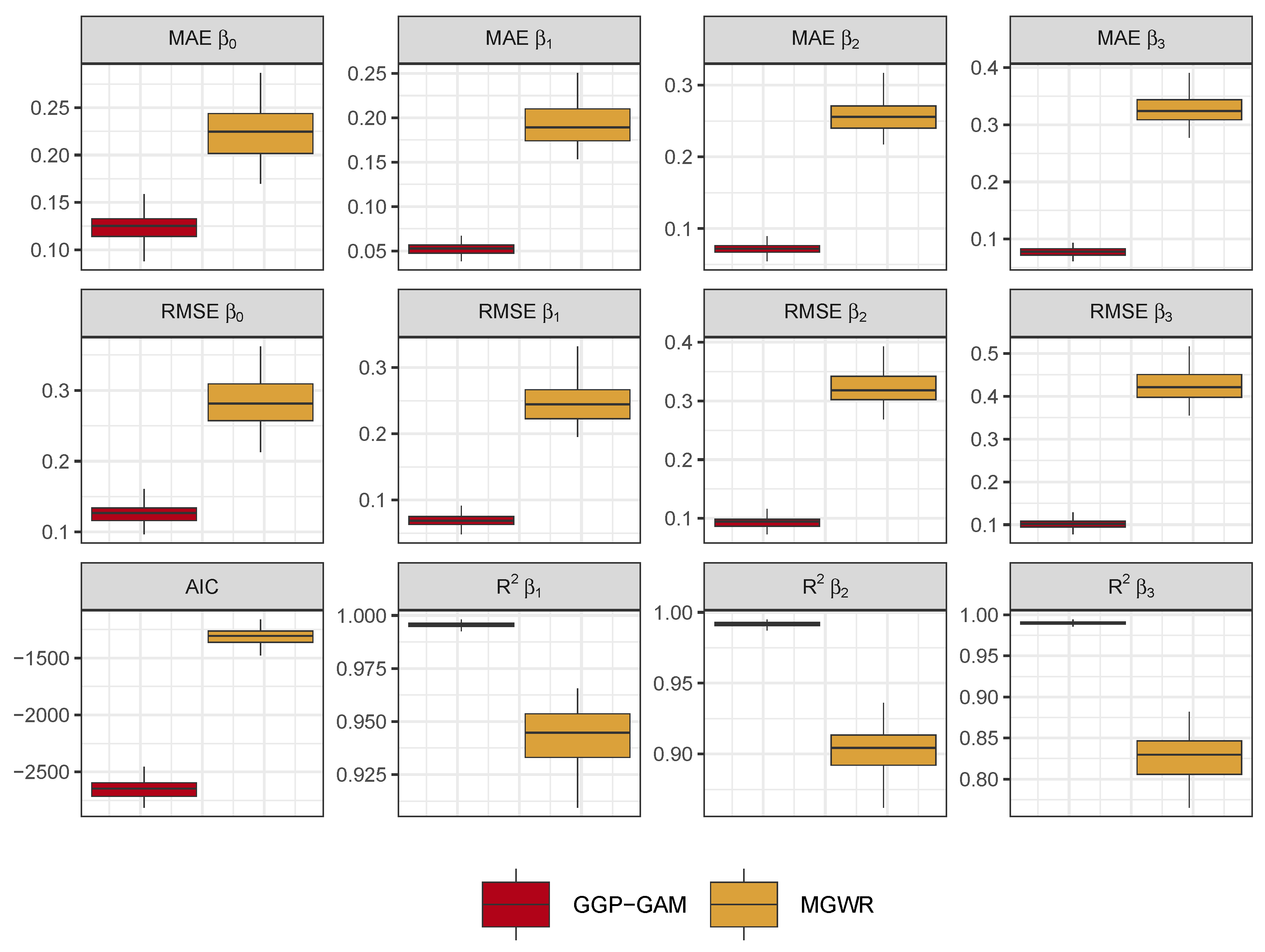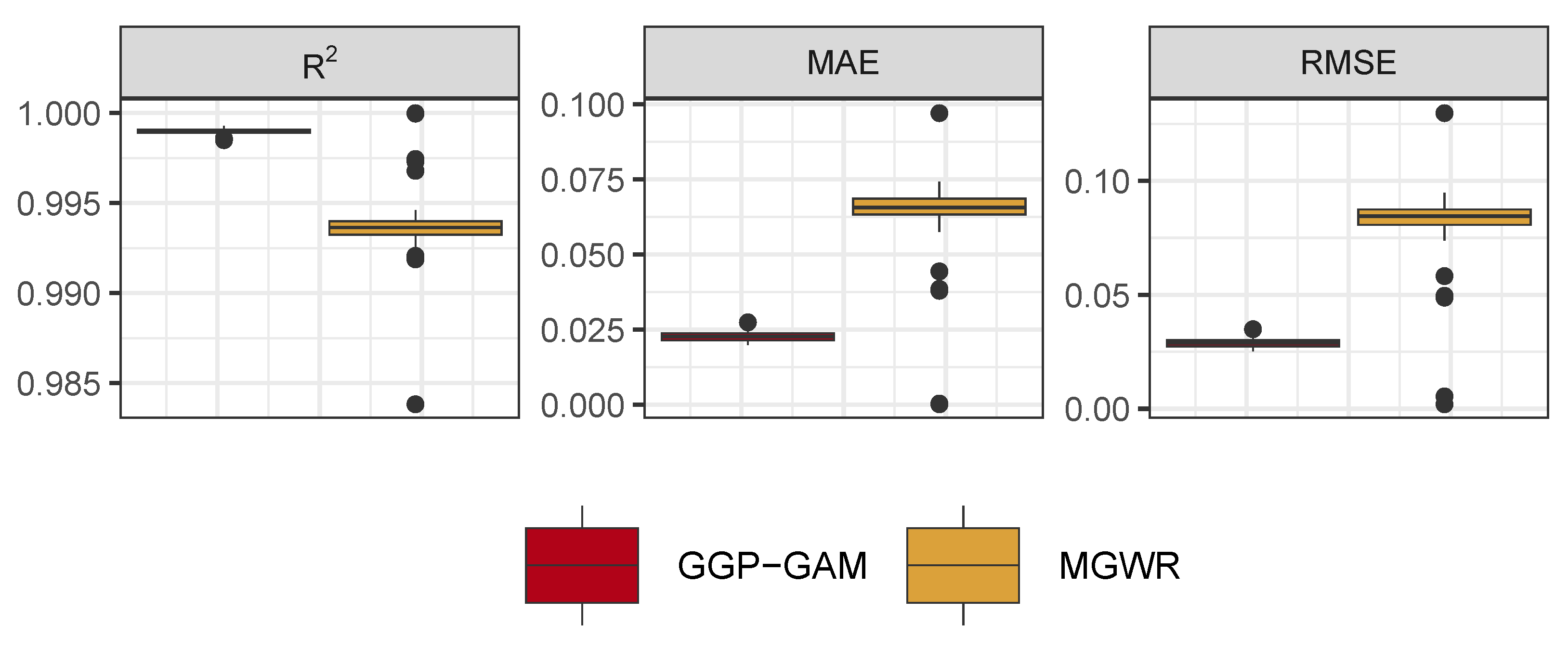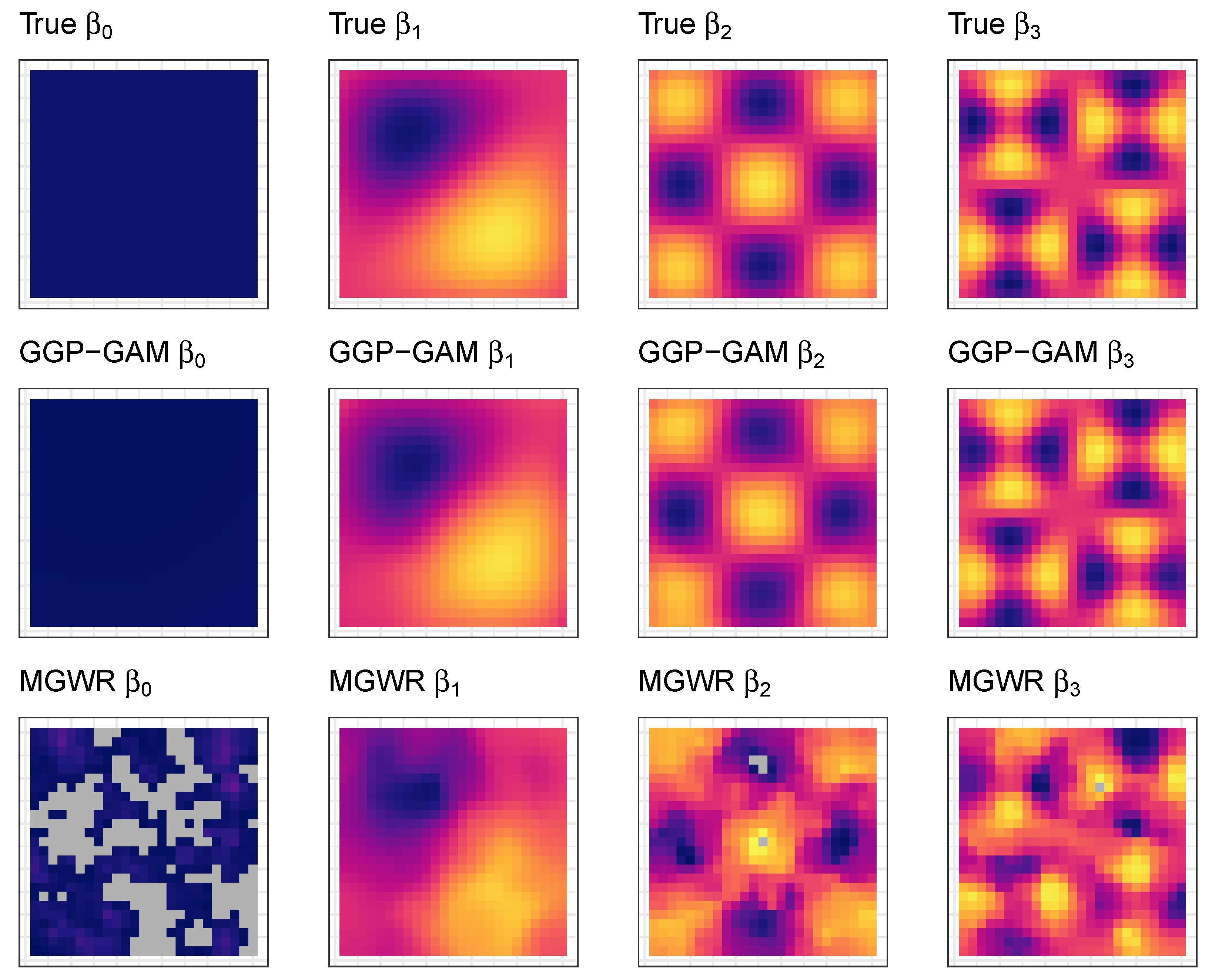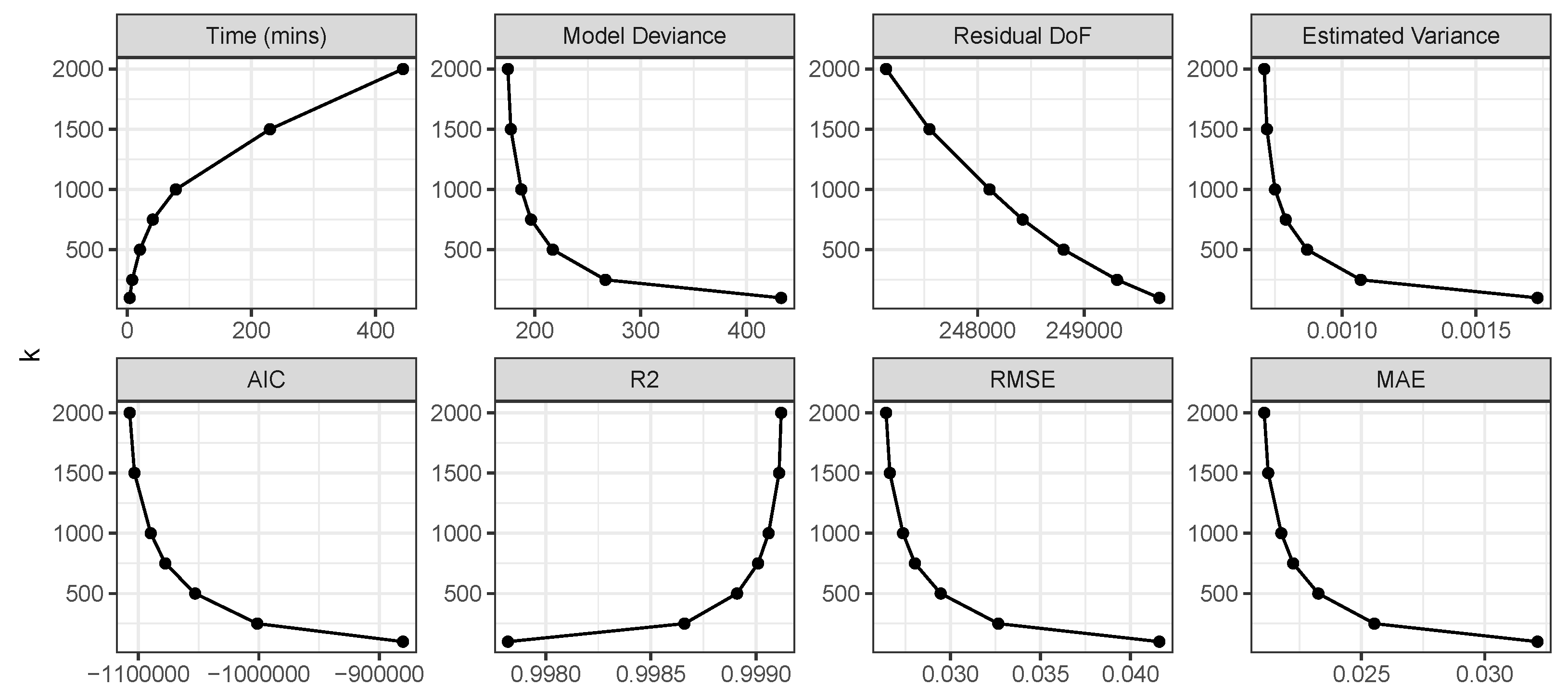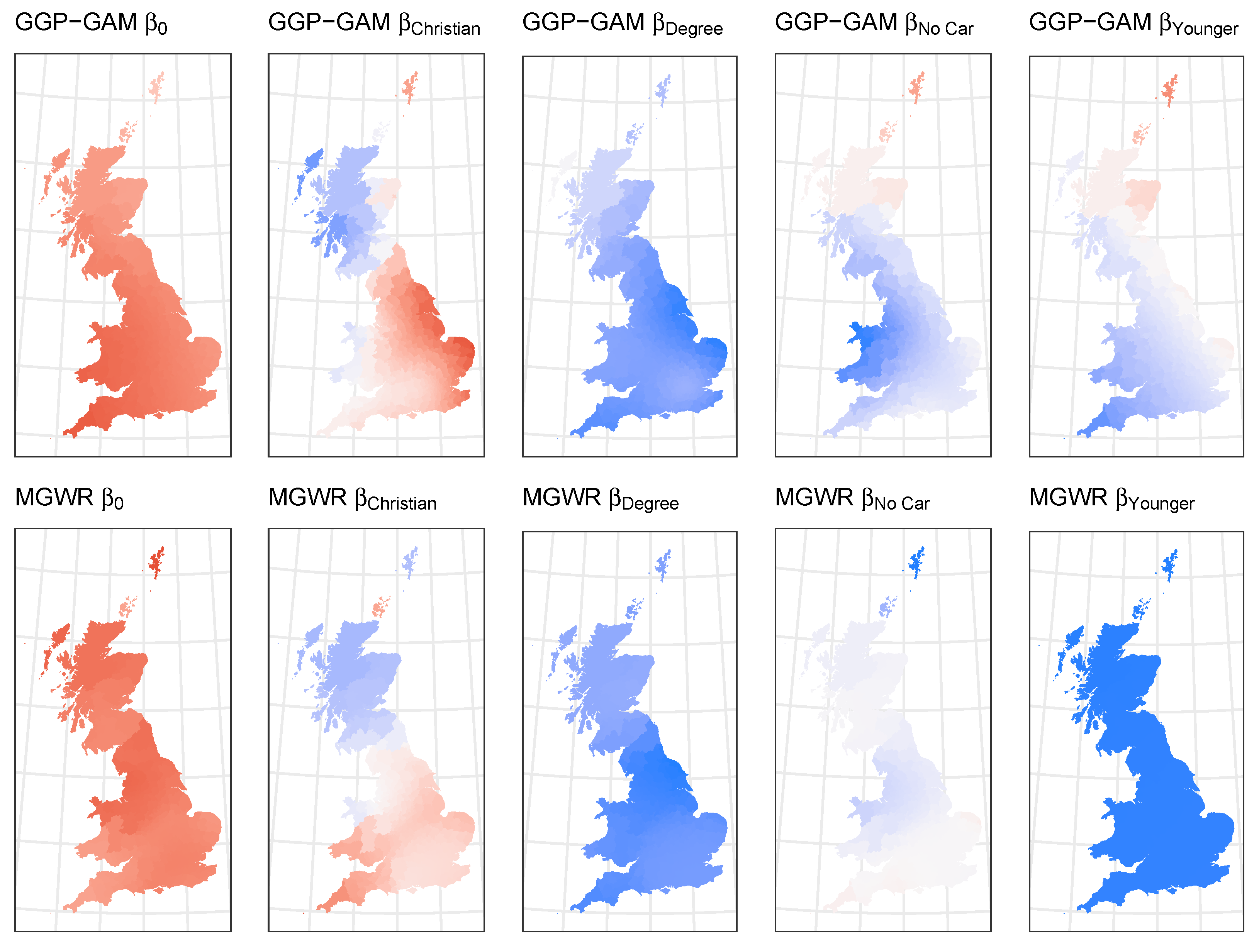1. Introduction
In regression, the relationship between response and predictor variables may vary with observation location. This may be due to a poor conceptual model; poor measurements with regional biases; omitted local factors or the presence of process spatial heterogeneity, also known as process spatial non-stationarity. In such cases, spatially varying coefficient (SVC) models provide an alternative to global or whole-map regressions, in which the relationships between response and predictor variables are assumed to be constant across space by relaxing the assumption of relationship spatial stationarity [
1]. SVC models allow relationships to vary with observation location and generate spatially distributed or local coefficient estimates. These quantify process spatial non-stationarity or spatial heterogeneity—a key and increasingly common task in spatial data analysis—and can be mapped to indicate how and where statistical relationships vary. SVCs provide insights into the spatially varying natures of different drivers of a response and can guide further investigations.
The SVC brand leader is Geographically Weighted Regression (GWR) [
2], which uses a single moving window or kernel whose size is optimised and determines the scale of spatial heterogeneity in the resultant outputs. GWR has been extended to a multiscale approach (MGWR) [
3,
4] in which individual kernels are fitted for each predictor variable, thereby capturing individual scales of the spatially varying relationships between predictor and response variables. MGWR is considered by some to be the default GWR model [
5]. However, there are a number of limitations associated with MGWR approaches, the main ones being that they cannot predict out of sample and that only approaches for Gaussian and Poisson responses have been developed [
6].
This paper addresses these critical gaps and describes a novel SVC modelling approach that uses Generalized Additive Models (GAMs) [
7,
8] with Gaussian Process (GP) smooths to capture process spatial non-stationarity. GAM smooths are commonly used to accommodate varying relationships between predictor and response variables in
attribute space. But if the smooths are parameterised with observation location, then the result is an SVC, as the relationship between the target variable and each predictor is estimated locally over
geographic space. The GAM-based SVC approach proposed in this paper—the Geographical Gaussian Process GAM (GGP-GAM)—is evaluated through three experiments. The first compares it with MGWR using simulated data with complex and highly localised degrees of spatial heterogeneity. Both models are fully tuned. The second investigates the ability of GGP-GAM to handle larger datasets and examines how performance is affected as the number of knots used in the smooths increases. Finally, an empirical case study of the UK referendum to leave the European Union in 2016 (Brexit) is used illustrate and compare MGWR and GAM-based approaches.
3. Methodology
Three analyses were undertaken. The first compared GGP-GAM and MGWR SVC models of 100 simulated datasets, each with 625 observations, a target variable (y) and 3 predictor variables (, and ). A second set of analyses investigated the ability of the GAM approach to handle larger datasets—in this case, with 250,000 observations—and model tuning via the knots parameter (k). The aim was to identify possible trade-offs between model performance, accuracy and computational cost. A third analysis compared GGP-GAM and MGWR using an empirical case study of the Brexit vote in the UK.
3.1. Data
For the first analysis comparing the proposed GGP-GAM and MGWR SVC models, a simulated spatially varying coefficient dataset was created, with three coefficients each having different degrees of spatial heterogeneity. This was created by extracting Moran eigenvectors [
13] generated using the
spmoran R package v0.3.3 [
34]. Here, the 1st, 10th and 25th surfaces were selected from the matrix of the first
L eigenvectors for a 25 by 25 grid (625 observations). Each coefficient surface, (termed
,
and
), had a normal distribution and was rescaled to have a mean of 0 and standard deviation of 1. An intercept surface (
) with a constant value of 2 was also defined. These represent the
true regression coefficients and are shown in
Figure 1.
One hundred simulated datasets were created from random generated values for
,
and
with a specified normal distribution, a mean of 0 and a standard deviation of 1. Each of these was min–max-transformed to have a range of (0, 1). Values for the error term (
) were generated in a similar way but min–max-transformed to have a range of (0, 0.25). The simulated response (
y) was calculated directly from these and the true coefficients (
Figure 1).
For the second analysis, a single simulated dataset was, again, created from Moran eigenvectors over a 500 by 500 grid. The 1st, 10th and 25th surfaces were extracted to create 250,000 observations with 3 true coefficients and an intercept surface with a constant value of 2. The coefficients had different spatial heterogeneities than those shown in
Figure 1. Values for
,
,
,
and
y were generated in the same way as for the smaller simulated study. The true coefficients are shown in
Figure 2. Note that the range of the true coefficients is slightly larger than that of those in
Figure 1, and their spatial variations are different.
3.2. GAM-Based SVC Models
The standard form for an OLS regression is
where for observations indexed by
,
is the response variable,
is the value of the
j-th predictor variable,
m is the number of predictor variables,
is the intercept term,
is the regression coefficient for the
j-th predictor variable and
is the random error term. This can be extended to define an SVC regression model:
where now
are the spatial coordinates of the observations
i and
are the coefficients estimated at those locations.
GAMs can also calibrate regression models in which the functions of the predictor variables are unknown, taking the following form:
where
is the intercept (
in Equations (
1) and (
2)) and the
j-th predictor
can be a scalar or a vector.
These can be extended so that each
becomes a linear regression coefficient on another scalar predictor in a linear regression (
):
Furthermore, if
, for example, and
z is a vector of locations or coordinates (similar to
in Equations (
1) and (
2)), then a spatially varying coefficient model is specified:
where
represents the
j-th SVC.
One approach to specifying
is to generate each function from a GP smooth defined as follows:
where
represents a basis function,
is the corresponding coefficient and
is the smoothing parameter. SVC
exhibits high spatial variation if
is large and remains constant if
. In this way, the smoothing parameter determines the wiggliness of the SVC, that is, how the function varies across its range.
The basis function (
) is specified such that
has a spatially smooth pattern—in this case, driven by the following covariance function:
where
represents the distance between locations
z and
and the covariance function
decreases with increases in
. This is similar to kriging and MGWR. Kriging uses covariance functions via the semi-variogram and a covariance function is calibrated individually for each
in the same way as bandwidths are optimised in MGWR. Thus a key task in using GAMs to model SVCs is to estimate the smoothness parameters
and thereby
.
A GAM employs smooth functions of the predictor variables, assuming that the values of the response variable (
y) follow some kind of exponential distribution:
where
,
,
and
are known functions and
is a vector of parameters. This has a flexible form and is, thus, able to handle a wide range of distributions, including Gaussian, Poisson, gamma or binomial distributions.
In summary, GAMs can estimate SVCs by modelling non-linear relationships as spatially non-stationary distributions using GP splines parameterised over geographical and attribute space, and a GP spline with spatial location is defined for each predictor variable (j). Additionally, an offset () is added to account for the GP’s zero mean, thereby creating the SVCs (). In the standard 2D case, defines the geographical Gaussian process GAM (GGP-GAM).
3.3. Analysis I: Comparing GGP-GAM and MGWR
GAMs with GP were undertaken using the
gam function in the
mgcv R package [
35]. The observed spatial locations (
z) were extracted and used to parameterise the splines with a GP smooth. The GPs constructed in this manner had a mean of zero; therefore, an additional fixed offset term was included for each predictor variable alongside the spatially smoothed terms.
There are some important tuning considerations in fitting GAMs with
mgcv, including the specification of spline smoothing parameters and the number of knots. These parameters influence the nature of the varying coefficients and the characterization of response-to-predictor relationships across space. The smoothing parameter regulates the degree of data smoothing through a correlation function, and the GAM function in the
mgcv package optimises this using an estimation method. In this case, REML was specified for optimization instead of a cross-validation estimator. The number of knots (
k) determines the basis dimensions; the maximum number of base functions used in the smooth; and, thus, the degree of sensitivity in fitting the model to the data. For example, consider the models predicting
y specified with different numbers of knots in
Figure 3. These determine the degree of relationship non-linearity in the smooth, together with the smoothing parameter. They are heuristically optimised by most GAM implementations in order to balance over-fitting with capturing relationship complexity. In the approach suggested by Wood [
35],
k can be manually and iteratively determined; an initial value is set, and the resultant splines are examined to determine whether the smoothing optimisation has converged and whether the basis dimensions defined by
k are adequate. If not, they are increased. For the first analysis comparing GGP-GAM and MGWR,
was specified after investigation.
The
GWmodel R package [
36,
37] was used to construct the MGWR models, which were specified with an adaptive bisquare kernel. Note that fixed kernels were also investigated, and the comparisons with the GGP-GAM results reported below were found to be similar. MGWR accommodates and quantifies varying degrees of spatial heterogeneity in the predictor-to-response relationships by determining an optimal kernel bandwidth for each predictor variable. Implementations of MGWR use a back-fitting algorithm to do this [
37,
38,
39]. Here, the convergence of the back-fitting procedure was evaluated through cross-validation of the residual sum of squares, and the threshold for convergence was set at
or 2000 convergence iterations.
In the first analyses, the GGP-GAM and MGWR models were fitted to the 100 simulated datasets with 625 observations. The SVC estimates were extracted for each model, along with predictions of
y (i.e.,
) for each observation. Measures of fit were calculated from the model coefficient estimates with the true ones in
Figure 1, including R
2 for
,
and
(
is stationary) and RMSE and MAE for
,
,
and
. Model AIC measures were also calculated. Finally, the model residuals (
) were also extracted to compare their spatial autocorrelation. To ensure consistency, functions for AIC, MAE, RMSE and R
2 were coded rather than using the values generated by the outputs of the
mgcv and the
GWmodel packages.
3.4. Analysis II: GGP-GAM Tuning with a Larger Dataset
A second set of analyses investigated model tuning via the knots parameter (k) using a single larger dataset with 250,000 observations. The aim was to identify any trade-offs between performance, computational efficiency and accuracy. Seven GGP-GAMs were specified, each with an increasing number knots. The effects of increasing k were evaluated through computation time, coefficient accuracy and predictive performance. Again, these were implemented in the mgcv package but using the bam function with parallel processing. Each model had the same input data but with the k parameter varying.
3.5. Empirical Example: Brexit Vote
A final comparative analysis was undertaken using an empirical example. This used data from the 2016 referendum on leaving the European Union for England, Wales and Scotland (the Brexit vote) [
40] and compared GGP-GAM and MGWR models. The spatial distribution of the Leave vote share (the response variable) over 380 Local Authority Districts is shown in
Figure 4. This suggests that the overall outcome of a 51.9% majority in favour of ‘Leave’ conceals notable regional patterns. For this example, predictor variables from the 2011 UK Census were analysed:
Christian is the proportion stating their religion as Christian,
Degree is the proportion with a bachelor’s degree,
No Car is the proportion who do not own a car or van and
Younger is the proportion of the electorate between the ages of 20 and 44 years old. The variables were not rescaled.
5. Discussion
There is increasing interest in SVC models because of their ability to accommodate, capture and describe process spatial non-stationarity via regression coefficient estimates that vary geographically. Data are increasingly spatial (i.e., observation location is included in some form), and consequently, more researchers are working with spatial data. SVC models are attractive because they provide an indication of how and where statistical relationships vary over space, and the results can be mapped, providing insights about the spatial heterogeneity of the process being examined.
Some initial work has proposed SVC models using GAMs with Gaussian process smooths that include observation location—a Geographical GP GAM (GGP-GAM)—and a comparative study with MGWR was undertaken [
33]. This used a different, less spatially complex set of simulated data to those presented here and accepted the default settings for GAMs in the
mgcv package [
35]. In this study, GGP-GAM and MGWR were applied to a more spatially complex set of simulated data (i.e., with much greater spatial heterogeneity), and the GGP-GAMs were tuned by specifying a sufficiently large number of knots such that the properties of the smooths converged. This was because the number of knots defines the basis dimension in the GP splines and the high value ensured sufficient degrees of freedom in each of the smooths. MGWR tuning was automatically undertaken during bandwidth optimisation.
The first part of this study compared GGP-GAM and MGWR SVC models of 100 simulated datasets, each with 625 observations. The GGP-GAMs performed better than MGWR across a range of fit measures, although a higher degree of variation was found in the GGP-GAM smoothing parameters than in the MGWR bandwidths (
Table 3). The GGP-GAM generated more accurate coefficient estimates than MGWR, a finding that was confirmed when the MGWR analyses were re-run with fixed distance bandwidths rather than adaptive ones. On investigation, the difference in performance was found to be due to the relatively higher residuals arising from the MGWR models, although, objectively, both models performed well. This resulted in the MGWR model struggling to estimate the known, true coefficients (
Figure 7) and suggests that MGWR models (and potentially other geographically weighted approaches) may struggle with more complex, highly localised spatial heterogeneities due to their rudimentary kernel/moving window-based formulation. Further investigation is required to confirm this assertion.
A second set of analyses applied the GGP-GAM to a larger simulated dataset, and a series of models were constructed with varying values of k, defining the number of knots. The results indicate excellent measures of fit at all values of k, and a degree stability in the GGP spline smooths was found for , suggesting that acceptable degrees of trade-off are possible between model complexity, computation times and GGP-GAM stability. Identifying the value of k at which model performance stabilises has operational benefits: the value of k determines the upper limit on the effective degrees of freedom linked to spline smoothness and, consequently, the spline bases. Increasing k also prolongs computation time. However, determining the optimal k algorithmically for a given case study is challenging. A common approach is to explore various k values and increasing and decreasing them as necessary. Here, it was shown that the gains at values of resulted in marginal performance gains at the cost of increases in computation time (a few minutes vs. a few hours).
The final analysis constructed and compared GGP-GAM and MGWR SVC models of the UK’s Brexit referendum vote to leave the European Union in 2016 with a small number of socio-economic variables. Both approaches generated similarly accurate models in terms of the ability to model the Leave vote share. The spatially varying coefficient estimates they generated indicated minor differences locally, with perhaps the greatest differences evident in the extremes of the study area. Consider, for example, the coefficients for Christian and No Car in the Shetland Islands in
Figure 9: these are positive in the GGP-GAM and negative in the MGWR model, reflecting the smoothing effect of the GWR-based moving window approach and, potentially, the adaptive distance kernel. There were also difference in the predictor variables that were found to have a local relationship with the target variable. In sum, the MGWR and GGP-GAM approaches generated similar understandings of the process in this empirical case study but with differences in the geographical extremes. This may be due to the way that GWR-based approaches capture spatial non-stationarity: they move a weighted window across observations and estimate coefficients at each location rather than quantifying local variation in ‘data’ space [
22]. Further work will seek to unpack these differences.
Other of areas of work are suggested by the findings of this study. One is to explore how the GGP-GAM approach may be further calibrated through out-of-sample predictions over randomly selected spatial data subsets. MGWR approaches are unable to do this because of their iterative back-fitting approach to model calibration. As a consequence, they cannot be applied to ‘new’ data. Another is to continue to extend the
stgam R package [
41]. Initial work on spatially varying coefficient modelling using GGP-GAMs simply coded the analysis in R. But as analyses progressed, the
stgam package was developed to contain tools and wrapper functions for creating SVC models using GAMs with GP smooths. The functionality of this toolkit will continue to be expanded. One particular area of development is the generation of explicit measures of the scale of spatial dependencies in the coefficient estimates. In MGWR, this is provided by the kernel bandwidth, and in GGP-GAMs, a similar indication of scale could be to determine the variogram range for each spatially varying coefficient. There are also further opportunities arising from the core theory underpinning GAMs [
7,
8,
35]. GGP-GAMs are more flexible than GWR-based approaches. They are inherently multiscale through their specification, and they are able to handle different responses, as well as having options for handling collinearity, outliers, and heteroskedastic and autocorrelated error terms—options that are not readily available for MGWR, aside from recent work on MGWR with autocorrelated errors [
42] and Poisson responses [
6]. Finally, extensions into space-time will be explored to investigate how to model space-time dependencies [
43], potentially using model averaging [
44] to determine optimal space-time model form. The ability to construct coefficient models in which the coefficients are allowed to vary over space and/or time is key in, for example, analysis of resilience to climate change, where the aim is to determine the varying drivers of changes in resilience and to predict tipping points.


